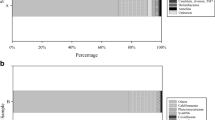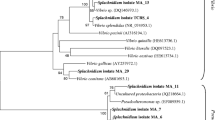Abstract
In this study, we have investigated the phylogeny and the antagonistic interactions of culturable bacteria isolated from the sea urchin Paracentrotus lividus collected from Aber and Morgat, both located in Crozon peninsula, France. Bacteria were isolated from the gastrointestinal tracts of ten specimens by using conventional culture-dependent method and then investigated by using phylogenetic analysis based on 16S rRNA gene sequence comparisons. Assays for antagonistic interactions among the bacterial strains were performed; bacteria (including at least one strain representative of each OTU identified) were screened for antimicrobial substance production. So, 367 bacterial strains were isolated on marine-agar. On the basis of morphological characteristics, 180 strains were sequenced and 94 OTUs were classified. The dominant phyla were Proteobacteria, Firmicutes and Actinobacteria, with a high abundance of the strains belonging to the genus Psychrobacter. From the antagonistic interactions assays, it could be determined that 22.7% strains were positive for at least one antagonism interaction, 18.3% of them isolated from the sea urchins collected in Morgat. We hypothesize that the bacteria isolated in this study may represent the transitory microbiota of the gastrointestinal tract of P. lividus, and that this microbiota may be related to the diet of this marine invertebrate. Furthermore, our results suggest that chemical antagonism could play a significant role in shaping the bacterial communities within gastrointestinal tract of the sea urchins. In addition, most isolated bacteria may have promising biotechnology applications.




Similar content being viewed by others
References
Andrew N, Agatsuma Y, Ballesteros E, Bazhin A, Creaser E, Barnes D et al (2002) Status and management of world sea urchin fisheries. Oceanogr Mar Biol Annu Rev 40:343–425. https://doi.org/10.1201/9780203180594.ch7
Becker PT, Egea E, Eeckhaut I (2008) Characterization of the bacterial communities associated with the bald sea urchin disease of the echinoid Paracentrotus lividus. J Invertebr Pathol 98:136–147. https://doi.org/10.1016/j.jip.2007.12.002
Becker PT, Gillan DC, Eeckhaut I (2007) Microbiological study of the body wall lesions of the echinoid Tripneustes gratilla. Dis Aquat Organ 77:73–82. https://doi.org/10.3354/dao01821
Becker PT, Gillan DC, Eeckhaut I (2009) Characterization of the bacterial community associated with body wall lesions of Tripneustes gratilla (Echinoidea) using culture-independent methods. J Invertebr Pathol 100:127–130. https://doi.org/10.1016/j.jip.2008.11.002
Benson AK, Kelly SA, Legge R, Ma F, Low SJ, Kim J et al (2010) Individuality in gut microbiota composition is a complex polygenic trait shaped by multiple environmental and host genetic factors. Proc Natl Acad Sci USA 107:18933–18938. https://doi.org/10.1073/pnas.1007028107
Boudouresque C, Verlaque M (2001) Ecology of Paracentrotus lividus. Dev Aquac Fish Sci 32:177–216. https://doi.org/10.1016/S0167-9309(01)80013-2
Boudouresque C, Verlaque M (2013) Ecology of Paracentrotus lividus developments in aquaculture and fisheries science. In: LawrenceJM (ed) Sea urchins: biology and ecology. Elsevier, Oxford, pp 297–327
Bowman JP, Cavanagh J, Austin JJ, Sanderson K (1996) Novel Psychrobacter species from Antarctic ornithogenic soils. Int J Syst Bacteriol 46:841–848
Bowman JP (2006) The genus Psychrobacter. Prokaryotes 6:920–930. https://doi.org/10.1007/0-387-30746-x_35 (CHAPTER 3.3.35)
Bull AT, Stach JE, Ward AC, Goodfellow M (2005) Marine actinobacteria: perspectives, challenges, future directions. Antonie Van Leeuwenhoek 87:65–79
Caporaso JG, Kuczynski J, Stombaugh J, Bittinger K, Bushman FD, Costello EK et al (2010) QIIME allows analysis of high-through put community sequencing data. Nat Methods 7:335–336. https://doi.org/10.1038/nmeth.f.303
Catarino AI, Bauwens M, Dubois P (2012) Acid–base balance and metabolic response of the sea urchin Paracentrotus lividus to different seawater pH and temperatures Environ. Sci Pollut Res 19:2344–2353
De Filippo C, Cavalieri D, Di Paola M, Ramazzotti M, Poullet JB, Massart S et al (2010) Impact of diet in shaping gut microbiota revealed by a comparative study in children from Europe and rural Africa. Proc Natl Acad Sci USA 107:14691–14696. https://doi.org/10.1073/pnas.1005963107
De Ridder C, Foret TW (2001) Non-parasitic symbioses between echinoderms and bacteria. In: Jangoux M, Lawrence JM (eds) Echinoderm studies. AA Balkema, Rotterdam, pp 111–169
Flemer B, Kennedy J, Margassery LM, Morrissey JP, O’Gara F, Dobson AD (2011) Diversity and antimicrobial activities of microbes from two Irish marine sponges, Suberitescarnosus and Leucosolenia sp. J Appl Microbiol 112:289–301. https://doi.org/10.1111/j.1365-2672.2011.05211.x
Gong AN, Li HP, Shen L, Zhang JB, Wu AB, He WJ et al (2015) The Shewanella algae strain YM8 produces volatiles with strong inhibition activity against Aspergillus pathogens and aflatoxins. Front Microbiol 6:1091. https://doi.org/10.3389/fmicb.2015.01091
Hau HH, Gralnick JA (2007) Ecology and biotechnology of the genus Shewanella. Annu Rev Microbiol 61:237–258
Hibbing ME, Fuqua C, Parsek MR, Peterson SB (2010) Bacterial competition: surviving and thriving in the microbial jungle. Nat Rev Microbiol 8:15–25
Kanagasabhapathy M, Sasaki H, Nagata S (2008) Phylogenetic identification of epibiotic bacteria possessing antimicrobial activities isolated from red algal species of Japan. World J Microbiol Biotechnol 24:2315–2321. https://doi.org/10.1007/s11274-008-9746-y
Laport MS, Santos-Gandelman JF, Muricy G, Giambiade-deMarval M, George I (2016) Antagonistic interactions among bacteria isolated from either the same or from different sponges native to the Brazilian coast. J Marine Sci Res Dev 6:185. https://doi.org/10.4172/2155-9910.1000185
Laport MS, Bauwens M, Nunes SO, Willenz P, George I, Muricy G (2017) Culturable bacterial communities associated to Brazilian Oscarella species (Porifera: Homoscleromorpha) and their antagonistic interactions. Antonie Van Leeuwenhoek 110:489–499. https://doi.org/10.1007/s10482-016-0818-y
Lawrence J, Lawrence A, Watts S (2013) Feeding, digestion, and digestibility of sea urchins. In: Lawrence JM (ed) Sea urchins: biology and ecology. Elsevier, Oxford, pp 135–154
Ley RE, Backhed F, Turnbaugh P, Lozupone CA, Knight RD, Gordon JI (2005) Obesity alters gut microbial ecology. Proc Natl Acad Sci USA 102:11070–11075
Lupp C, Finlay BB (2005) Intestinal microbiota. Curr Biol 15:R235–R236. https://doi.org/10.1016/j.cub.2015.06.031
Marinho PR, Moreira AP, Pellegrino FL, Muricy G, Bastos MC, Santos KR et al (2009) Marine Pseudomonas putida: a potential source of antimicrobial substances against antibiotic-resistant bacteria. MIOC 104:678–682
Martín-Rodríguez AJ, González-Orive A, Hernández-Creus A, Morales A, Dorta-Guerra R, Norte M et al (2014) On the influence of the culture conditions in bacterial antifouling bioassays and biofilm properties: Shewanella algae, a case study. BMC Microbiol 14:102. https://doi.org/10.1186/1471-2180-14-102
Mayer LM, Jumars PA, Bock MJ, Vetter YA, Schmidt JL (2001) Two roads to sparagmos: extracellular digestion of sedimentary food by bacterial inoculation versus deposit feeding. In: Aller JY, Woodin SA, Aller RC (eds) Organism-sediment interactions. University of South Carolina, Columbia, pp 335–347
McClay DR (2011) Evolutionary cross roads in developmental biology: sea urchins. Development 138:2639–2648. https://doi.org/10.1242/dev.048967
Meziti AK, Kormas AR, Pancucci-Papadopoulou M-A, Thessalou-Legaki M (2007) Bacterial phylotypes associated with the digestive tract of the sea urchin Paracentrotus lividus and the ascidian Microcosmus sp. Russ J Mar Biol 33:84–91
Muraoka DD (1990) Managing the sea urchin fishery: an economic perspective. Nat Resour J 30:139
Nelson L, Blair B, Murdock C, Meade M, Watts S, Lawrence AL (2010) Molecular Analysis of gut microflora in captive-raised sea urchins (Lytechinus variegatus). J World Aquac Soc 41:807–815
Olson JB, Kellogg CA (2010) Microbial ecology of corals, sponges, and algae in mesophotic coral environments. FEMS Microbiol Ecol 73:17–30
Pinsino A, Matranga V, Trinchella F, Roccheri MC (2010) Sea urchin embryos as an in vivo model for the assessment of manganese toxicity: developmental and stress response effects. Ecotoxicology 19:555–562
Quillien N, Nordström MC, Le Bris H, Bonsdorff E, Grall J (2017) Green tides on inter- and subtidal sandy shores: differential impacts on infauna and flatfish. J Mar Biol Assoc UK. https://doi.org/10.1017/S0025315416002010
Quince C, Lanzen A, Davenport RJ, Turnbaugh PJ (2011) Removing noise from pyrosequenced amplicons. BMC Bioinform 12:38. https://doi.org/10.1186/1471-2105-12-38
Rothschild LJ, Mancinelli RL (2001) Life in extreme environments. Nature 409:1092–1101
Rua CP, Trindade-Silva AE, Appolinario LR, Venas TM, Garcia GD, Carvalho LS et al (2014) Diversity and antimicrobial potential of culturable heterotrophic bacteria associated with the endemic marine sponge Arenosclera brasiliensis. Peer J 2:e419. https://doi.org/10.7717/peerj.419
Ruppert EE, Barnes RD (1997) Invertebrate zoology, 6th edn. Saunders College Publishing, Orlando
Santos-Gandelman JF, Giambiagi-deMarval M, Oelemann WMR, Laport MS (2014) Biotechnological potential of sponge-associated bacteria. Curr Pharm Biotechnol 15:143–155
Sauchyn LK, Lauzon-Guay J-S, Scheibling RE (2011) Sea urchin fecal production and accumulation in a rocky subtidal ecosystem. Aquat Biol 13:215–223. https://doi.org/10.3354/ab00359
Sauchyn LK, Scheibling RE (2009) Degradation of sea urchin feces in a rocky subtidal ecosystem: implications for nutrient cycling and energy flow. Aquat Biol 6:99–108. https://doi.org/10.3354/ab00171
Sauchyn LK, Scheibling RE (2009) Fecal production by sea urchins in native and invaded algal beds. Mar Ecol Prog Ser 396:35–48. https://doi.org/10.3354/meps08296
Sommer F, Backhed F (2013) The gut microbiota: masters of host development and physiology. Nat Rev Microbiol 11:227–238
Turnbaugh PJ, Ley RE, Mahowald MA, Magrini V, Mardis ER, Gordon JI (2006) An obesity-associated gut microbiome with increased capacity for energy harvest. Nature 444:1027–1131
Ventura M, Turroni F, Canchaya C, Vaughan EE, O’Toole PW, Sinderen D (2009) Microbial diversity in the human intestine and novel insights from metagenomics. Front Biosci 14:3214–3863
Weisburg WG, Barns SM, Pelletier DA, Lane DJ (1991) 16S ribosomal DNA amplification for phylogenetic study. J Bacteriol 173:697–703
Wu GD, Chen J, Hoffmann C, Bittinger K, Chen YY, Keilbaugh SA et al (2011) Linking long term dietary patterns with gut microbial enterotypes. Science 334:105–108
Acknowledgements
This work was supported by the National Council for Scientific and Technological Development (CNPq), the National Council for the Improvement of Higher Education (CAPES), the Carlos Chagas Filho Foundation for Research Support of Rio de Janeiro State (FAPERJ) to Laport, MS and by a “Crédit de Recherches” grant from the Fonds de la Recherche Scientifique (FRS-FNRS) to George, I. We are also grateful to Science Without Borders, a CNPq Program for the post doctorate scholarship to Laport, MS; and to Prof. Philippe Dubois and Prof. Chantal de Ridder for accepting her in the “Laboratoire de Biologie Marine”, at “Université Libre de Bruxelles”, Belgium.
Author information
Authors and Affiliations
Corresponding author
Ethics declarations
Conflict of interest
No conflict of interest is declared.
Electronic supplementary material
Below is the link to the electronic supplementary material.
284_2017_1389_MOESM1_ESM.xlsx
Supplementary material 1—Culturable bacteria associated with the gut microbiota of the sea urchin (Paracentrotus lividus): Distribution, 16S rRNA gene sequence affiliation, accession numbers of the sequence data deposited in the GenBank database, abundance and taxonomic assignment of bacterial OTUs (XLSX 30 KB)
284_2017_1389_MOESM2_ESM.xlsx
Supplementary material 2—Distribution, abundance and taxonomic assignment of bacterial OTUs with just one sequence, Distribution, abundance and taxonomic assignment of bacterial OTUs with two or more sequences (XLSX 44 KB)
284_2017_1389_MOESM3_ESM.xlsx
Supplementary material 3—Antagonistic interactions among bacteria isolated from the gastrointestinal tract (stomach and intestine) of the sea urchins collected in Aber (XLSX 10 KB)
284_2017_1389_MOESM4_ESM.xlsx
Supplementary material 4—Antagonistic interactions among bacteria isolated from the gastrointestinal tract (stomach and intestine) of the sea urchins collected in Morgat (XLSX 13 KB)
Rights and permissions
About this article
Cite this article
Laport, M.S., Bauwens, M., Collard, M. et al. Phylogeny and Antagonistic Activities of Culturable Bacteria Associated with the Gut Microbiota of the Sea Urchin (Paracentrotus lividus). Curr Microbiol 75, 359–367 (2018). https://doi.org/10.1007/s00284-017-1389-5
Received:
Accepted:
Published:
Issue Date:
DOI: https://doi.org/10.1007/s00284-017-1389-5




